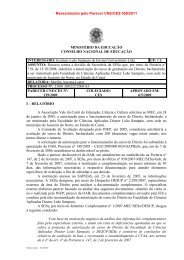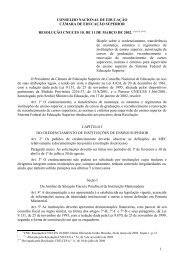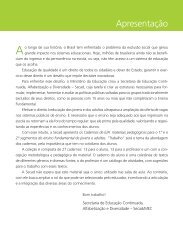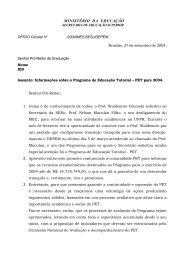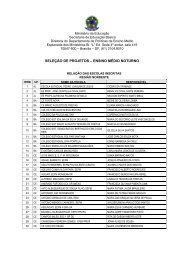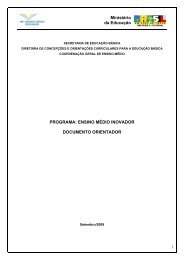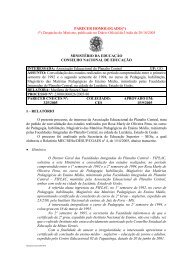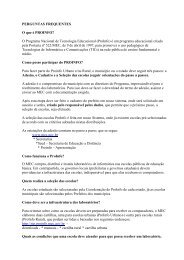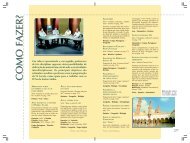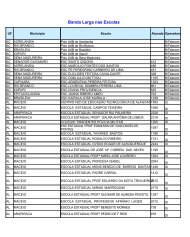Vinho - Ministério da Educação
Vinho - Ministério da Educação
Vinho - Ministério da Educação
You also want an ePaper? Increase the reach of your titles
YUMPU automatically turns print PDFs into web optimized ePapers that Google loves.
<strong>Ministério</strong> <strong>da</strong> <strong>Educação</strong><br />
Ministry of Education<br />
Secretaria de <strong>Educação</strong> Profissional e Tecnológica<br />
Secretariat for Vocational and Technology Education<br />
Brasília, setembro de 2005<br />
Brasília, September 2005<br />
<strong>Vinho</strong> Wine 1<br />
<strong>Vinho</strong><br />
wine
2<br />
<strong>Vinho</strong> Wine
Apresentação/Introduction<br />
As cartilhas temáticas sobre café, vinho e<br />
cachaça, publica<strong>da</strong>s pela Secretaria de <strong>Educação</strong><br />
Profissional e Tecnológica do <strong>Ministério</strong><br />
<strong>da</strong> <strong>Educação</strong> (Setec/MEC), apresentam alguns<br />
aspectos do trabalho realizado por escolas integrantes<br />
<strong>da</strong> rede federal, em colaboração com<br />
setores produtivos locais e regionais.<br />
Os exemplos apresentados nesses volumes<br />
resultam de uma política de educação profissional<br />
articula<strong>da</strong> com ações de desenvolvimento<br />
para a geração de emprego e ren<strong>da</strong><br />
de forma a combater as desigual<strong>da</strong>des sociais.<br />
Essa política pressupõe o papel decisivo<br />
<strong>Vinho</strong> Wine 3<br />
do Estado na indução do desenvolvimento<br />
econômico e social, com destaque para sua<br />
atuação na área de formação de trabalhadores.<br />
Ela trabalha na perspectiva do papel estratégico<br />
<strong>da</strong> educação profissional no processo<br />
de desenvolvimento regional.<br />
As cartilhas que você tem em mãos abor<strong>da</strong>m<br />
aspectos <strong>da</strong> história do café, do vinho e <strong>da</strong><br />
cachaça no Brasil, os cursos oferecidos pelas<br />
escolas <strong>da</strong> rede para formação de profissionais<br />
nessas áreas, as pesquisas desenvolvi<strong>da</strong>s nesses<br />
setores atualmente e também algumas<br />
maneiras de como saborear esses produtos.<br />
Antonio Ibañez Ruiz<br />
Secretário de <strong>Educação</strong> Profissional e Tecnológica<br />
The thematic pamphlets on coffee, wine, and cachaça, published by the Ministry of Education’s Secretariat<br />
for Vocational and Technology Education (Setec/MEC), touch on some facets of the work done by schools that<br />
comprise the federal education network in collaboration with local and regional producers.<br />
The examples mentioned in these publications bear the fruits of a vocational education policy, which is<br />
coupled with development initiatives aimed at creating jobs and bolstering income in the fight against social<br />
inequalities. This policy hinges on the central role played by the government in levering economic and social<br />
development by focusing on worker training initiatives. Furthermore, it acknowledges the strategic role of<br />
vocational education within regional development processes.<br />
These pamphlets discuss some aspects of the history of coffee, wine, and cachaça in Brazil, while also<br />
describing professional training courses and current research, as well as some ways of savoring these products.<br />
Antonio Ibañez Ruiz<br />
Secretary for Vocational and Technology Education
4<br />
<strong>Vinho</strong> Wine<br />
Bebi<strong>da</strong><br />
move economia<br />
<strong>da</strong> Serra Gaúcha<br />
É do Rio Grande do Sul que vem 90% <strong>da</strong><br />
produção brasileira de vinhos. No estado, a produção de uvas cresceu de 496,2 milhões de<br />
quilos, em 1985, para 578,7 milhões de quilos, em 2004. Minas Gerais, Paraná, Pernambuco,<br />
Santa Catarina e São Paulo dividem os outros 10% na fabricação <strong>da</strong> bebi<strong>da</strong>.<br />
Em Bento Gonçalves, na Serra Gaúcha, quase 1,8 mil proprie<strong>da</strong>des produzem uvas. São<br />
5,6 mil hectares de vinhedos comerciais, dos quais 84% cultivam uvas americanas e híbri<strong>da</strong>s,<br />
usa<strong>da</strong>s para elaborar vinhos comuns e sucos de uva, e 16%, uvas viníferas, para fabricação de<br />
vinhos finos.<br />
Na Serra Gaúcha – que inclui, além de Bento Gonçalves, as ci<strong>da</strong>des de Bagé, Caxias do Sul,<br />
Encruzilha<strong>da</strong> do Sul, Flores <strong>da</strong> Cunha, Garibaldi, Pinheiro Machado e Santana do Livramento<br />
– grande parte dos agricultores utiliza mão-de-obra familiar, geralmente forma<strong>da</strong> pelo Centro<br />
Federal de <strong>Educação</strong> Tecnológica (Cefet) de Bento Gonçalves, do <strong>Ministério</strong> <strong>da</strong> <strong>Educação</strong>.<br />
Cerca de duas mil famílias de agricultores vivem do cultivo de uvas nesta região vinícula que<br />
é a maior do Rio Grande do Sul. O município tem cerca de 100 mil habitantes, em sua maioria<br />
descendentes de imigrantes italianos, e as proprie<strong>da</strong>des rurais possuem até 12 hectares de área.
The beverage that<br />
drives the Serra<br />
Gaucha economy<br />
90% of all wine produced in Brazil comes from<br />
the State of Rio Grande do Sul. The remaining 10% is<br />
produced in the States of Minas Gerais, Paraná,<br />
Pernambuco, Santa Catarina, and São Paulo. Grape<br />
production in Rio Grande do Sul rose from 496.2<br />
million kilos in 1985 to 578.7 million kilos in 2004.<br />
Nestled in the Serra Gaúcha mountain range,<br />
Bento Gonçalves has nearly 1800 grape-producing<br />
properties and 5,600 hectares of commercial<br />
vineyards. On 84% of these vineyards, American<br />
and hybrid grapes are grown for making table<br />
wines and grape juices, whereas the remaining<br />
16% grow European, or vinifera, grape varieties for<br />
making fine wines.<br />
A large portion of farmers in the Serra Gaúcha –<br />
which encompasses Bento Gonçalves, Bagé, Caxias<br />
do Sul, Encruzilha<strong>da</strong> do Sul, Flores <strong>da</strong> Cunha,<br />
Garibaldi, Pinheiro Machado, and Santana do<br />
Livramento – use family labor often trained by the<br />
Bento Gonçalves Federal Center of Technology<br />
Education (Cefet), under the Ministry of Education.<br />
Home to two thousand families which make<br />
their living growing grapes, this region is the largest<br />
grape-producing region in the State of Rio Grande<br />
do Sul. Most of its 100 thousand inhabitants are<br />
descendents of Italian immigrants and rural<br />
properties are generally smaller than 12 hectares.<br />
<strong>Vinho</strong> Wine 5
6<br />
<strong>Vinho</strong> Wine
Cor, aroma e sabor<br />
<strong>Vinho</strong> Wine 7<br />
Na avaliação <strong>da</strong> quali<strong>da</strong>de de um vinho, primeiro verifique sua cor. Depois, sinta o aroma<br />
e o sabor.<br />
Contra uma superfície luminosa, veja as lágrimas, a limpidez, a intensi<strong>da</strong>de de cor e a<br />
tonali<strong>da</strong>de do vinho. A profundi<strong>da</strong>de <strong>da</strong> cor pode ser percebi<strong>da</strong> ao se colocar a taça contra<br />
uma superfície branca e olhá-la de cima para baixo. Observe se há presença de gás carbônico,<br />
um defeito principalmente nos vinhos tintos.<br />
O exame olfativo é feito, primeiramente, com o copo em repouso, seguido por um<br />
leve movimento giratório. Depois, movimente a taça mais vigorosamente e sinta o cheiro<br />
novamente.<br />
Na boca, atente para a primeira impressão, a evolução do sabor, o equilíbrio entre álcool e<br />
acidez, as sensações tácteis <strong>da</strong> mucosa, a persistência e a sensação final.<br />
Color, aroma, and flavor<br />
In evaluating a wine’s quality, first observe its<br />
color. Then, smell its aroma and taste its flavor.<br />
On a well-lit background, observe the wine’s<br />
legs, its limpidity, as well as the intensity and hue of<br />
its colors. The depth of colors can be made out by<br />
putting the wine glass against a white surface and<br />
observing it from above. See if carbon gas is<br />
present, which would mean a defect, especially in<br />
red wines.<br />
In order to conduct the smell test, first smell the<br />
wine’s aroma without moving the glass, then swirl it<br />
around lightly, followed by a more vigorous swirl<br />
and another smell.<br />
As you swish it in your mouth, watch your first<br />
impressions, then observe the evolution of flavor,<br />
the balance between alcohol and acidity, the tactile<br />
sensations on the inner lining of your mouth, the<br />
aftertaste, and the final sensation.
8<br />
<strong>Vinho</strong> Wine<br />
Ao beber um cálice de vinho, observe a intensi<strong>da</strong>de<br />
<strong>da</strong>s “lágrimas” forma<strong>da</strong>s junto à parede<br />
<strong>da</strong> taça. Apesar de composta principalmente<br />
por água, sua formação é mais intensa quanto<br />
maior for a quanti<strong>da</strong>de de álcool. A limpidez<br />
do vinho também deve ser percebi<strong>da</strong>. Enquanto<br />
os de melhor quali<strong>da</strong>de são brilhantes e cristalinos,<br />
os piores apresentam partículas em suspensão<br />
e são turvos e opacos. Algumas vezes,<br />
vinhos tintos de quali<strong>da</strong>de envelhecidos por<br />
longo tempo podem ter partículas em suspensão,<br />
que devem ser decanta<strong>da</strong>s.<br />
A intensi<strong>da</strong>de <strong>da</strong> cor de um vinho pode ser<br />
leve, fraca, média ou intensa, e sua tonali<strong>da</strong>de<br />
varia, nos brancos, do incolor ao dourado e,<br />
nos tintos, do clarete ao púrpura, com varian-<br />
tes entre o carmim, o vermelho-rubi e o violeta.<br />
<strong>Vinho</strong>s tintos envelhecidos podem ter coloração<br />
menos intensa, com reflexos de cor de<br />
tijolo ou telha e sua tonali<strong>da</strong>de dependerá do<br />
grau de maturação <strong>da</strong>s uvas, do processo de<br />
elaboração, <strong>da</strong> varie<strong>da</strong>de e <strong>da</strong> i<strong>da</strong>de <strong>da</strong> bebi<strong>da</strong>.<br />
When you drink a glass of wine, watch the intensity of the wine’s legs on the inside of the glass as you<br />
swirl it around. Though made up mainly of water, wine’s consistency increases as the alcohol content rises.<br />
One must also observe wine’s limpidity. While the highest quality wines are bright and crystalline, the<br />
worst ones, which have suspended particles, are turbid and opaque. In some cases, high-quality red wines that<br />
have aged for a long time may contain suspended particles, which must be decanted.<br />
The intensity of wine’s color may be light, soft, medium, or intense. Its hues, in white wines, range<br />
from colorless to golden and, in reds, from claret to purple, with nuances of crimson, ruby, and violet red.<br />
Aged red wines may have less intense coloration with tints of brick or tile red, which depends on the<br />
maturity of the grapes, on the winemaking process, as well as on the variety and age.
<strong>Vinho</strong> Wine 9
10<br />
<strong>Vinho</strong> Wine<br />
O OLFATO é também importante na análise<br />
de um vinho e os aromas podem ser classificados<br />
quanto à intensi<strong>da</strong>de, característica<br />
e quali<strong>da</strong>de, <strong>da</strong> seguinte forma:<br />
♦ Intensi<strong>da</strong>de – neutro, fraco, pobre, rico<br />
e aromático ;<br />
♦ Característica – varietal, especiarias, animal,<br />
vegetal, essências, frutado, floral,<br />
tostado e químico;<br />
♦ Quali<strong>da</strong>de – aroma primário (associado<br />
à varie<strong>da</strong>de <strong>da</strong> uva), aroma secundário<br />
(proveniente <strong>da</strong> fermentação) e buquê (associado<br />
ao envelhecimento).<br />
AO SABOREAR o vinho, características<br />
como acidez, doçura, salini<strong>da</strong>de e amargor<br />
são facilmente percebi<strong>da</strong>s. Os vinhos podem<br />
ser mais ou menos ácidos, doces ou<br />
licorosos e a persistência do sabor pode ser<br />
curta ou longa.<br />
♦ Acidez – chato (baixa), fresco, vivaz,<br />
acerbo, ácido e acídulo.<br />
♦ Doçura – seco, doce e licoroso.<br />
♦ Salini<strong>da</strong>de – pouco ou na<strong>da</strong> perceptível.<br />
♦ Amargor – depende de conteúdo de taninos<br />
e compostos fenólicos.<br />
♦ Persistência – fugaz, curta, média e prolonga<strong>da</strong>.<br />
♦ Corpo – aguado, leve, encorpado, viscoso<br />
e espesso.
SMELL is also important in analyzing wines.<br />
Aromas are classified according to intensity,<br />
characteristics, and quality, which may be further<br />
broken down as follows:<br />
♦ Intensity – neutral, weak, poor, rich, and aromatic.<br />
♦ Characteristics – varietal, herbaceous, animal,<br />
plant, essences, fruity, floral, toasted, and chemical.<br />
♦ Quality – primary aroma (stemming from the grape<br />
variety), secon<strong>da</strong>ry aroma (due to fermentation),<br />
and bouquet (associated with aging).<br />
UPON SAVORING A WINE, one may also discern<br />
characteristics such as acidity, sweetness, salinity,<br />
and bitterness. Wines may have widely varying<br />
<strong>Vinho</strong> Wine 11<br />
degrees of acidy, sweet, or liqueur overtones, and<br />
their aftertaste may be short or long.<br />
♦ Acidity – flat (low), crisp, lively, acerbic, acidy,<br />
and acidulous.<br />
♦ Sweetness – dry, sweet, and liqueurous.<br />
♦ Salinity – low or unnoticeable.<br />
♦ Bitterness – depends on the levels of tannins<br />
and phenolic compounds.<br />
♦ Aftertaste – lacks finish, short, medium, long<br />
(lingering).<br />
♦ Body – watery, light-bodied, medium-bodied,<br />
full-bodied.
12<br />
<strong>Vinho</strong> Wine<br />
A temperatura<br />
Existe uma temperatura ideal que permite intensificar a percepção dos aromas e do sabor<br />
do vinho, equilibrando no pala<strong>da</strong>r as características de doçura, teor alcoólico, acidez, amargor<br />
e adstringência. Veja:<br />
<strong>Vinho</strong> Temperatura<br />
<strong>Vinho</strong>s tintos encorpados 16ºC a 18ºC<br />
<strong>Vinho</strong>s tintos jovens com menor corpo 12ºC a 14ºC<br />
<strong>Vinho</strong>s brancos secos maduros 12ºC a 14ºC<br />
<strong>Vinho</strong>s brancos secos leves 6ºC a 12ºC<br />
<strong>Vinho</strong>s rosés 6ºC a 12ºC<br />
<strong>Vinho</strong>s doces tintos ou brancos 4ºC a 6ºC<br />
Espumantes Brut e Prosecco 6ºC a 12ºC<br />
Espumantes Demi-sec 4ºC a 8ºC<br />
Espumantes Moscatel 4ºC a 6ºC<br />
<strong>Vinho</strong>s de quali<strong>da</strong>de<br />
A quali<strong>da</strong>de de um vinho resulta <strong>da</strong> harmonia<br />
de seus componentes. Além <strong>da</strong>s substâncias<br />
voláteis, que definem o aroma, são fun<strong>da</strong>mentais<br />
os compostos que participam na<br />
definição <strong>da</strong> cor, dos gostos e <strong>da</strong>s sensações tácteis.<br />
Mais que a concentração, o balanço entre<br />
todos esses componentes é o que define se um<br />
vinho é de quali<strong>da</strong>de ou medíocre.<br />
Uma bebi<strong>da</strong> de quali<strong>da</strong>de não possui odores<br />
estranhos, apresenta nitidez e fineza de<br />
aroma e sabor, boa intensi<strong>da</strong>de de pala<strong>da</strong>r e<br />
expressão varietal, se for o caso. É ain<strong>da</strong><br />
harmônica na relação entre o álcool e a acidez<br />
e tem persistência de retrogosto entre<br />
média e alta. O nível de adstringência e amargor<br />
é baixo e a acidez nunca é intensa. O gosto<br />
final é agradável, sem defeitos, e sem o predomínio<br />
de uma única sensação.
Temperature<br />
There is an ideal temperature for enhancing<br />
one’s perception of wine aromas and flavors which<br />
enables one’s palate to balance out sweetness,<br />
alcohol content, acidity, bitterness, and astringency.<br />
These temperatures are:<br />
Wine<br />
Full-bodied red wines<br />
Young light-bodied red wines<br />
Mature dry white wines<br />
Light dry white wines<br />
Rosé wines<br />
Sweet red or white wines<br />
Brut Sparkling wines and Prosecco<br />
Demi-sec Sparking wines<br />
Muscatel Sparkling wines<br />
Quality wines<br />
Temperature<br />
16ºC a 18ºC<br />
12ºC a 14ºC<br />
12ºC a 14ºC<br />
6ºC a 12ºC<br />
6ºC a 12ºC<br />
4ºC a 6ºC<br />
6ºC a 12ºC<br />
4ºC a 8ºC<br />
4ºC a 6ºC<br />
<strong>Vinho</strong> Wine 13<br />
A wine’s quality stems from a harmonious interplay between its components. Besides the volatile<br />
substances, which define its aroma, the compounds which help to define color, flavors, and tactile<br />
sensations are also essential. The balance between these components is what defines whether a wine is<br />
high quality or mediocre.<br />
A high-quality wine does not exude strange odors. One identifies a high-quality wine by its clarity, delicate<br />
aroma, and flavor, as well as by its intensity on the palate and by the expression of the grape variety. A highquality<br />
wine also strikes a balance between alcohol content and acidity, and has a medium to long aftertaste.<br />
With low astringency and bitterness levels, its acidity is never intense. The aftertaste of such a wine evokes a<br />
seamless and pleasant feeling in which no single sensation prevails.
14<br />
<strong>Vinho</strong> Wine<br />
A elaboração<br />
<strong>Vinho</strong>s de mesa<br />
Após a colheita, a uva é transporta<strong>da</strong> em<br />
caixas até a vinícola. Lá são pesa<strong>da</strong>s e o grau<br />
glucométrico é determinado para verificação<br />
do potencial alcoólico <strong>da</strong>s frutas. No início<br />
<strong>da</strong> vinificação, o engaço* e as bagas** são<br />
separados para limitar a adstringência e o<br />
amargor. Depois, o mosto*** é liberado <strong>da</strong>s<br />
bagas por esmagamento. Ambas as operações<br />
são feitas num único equipamento.<br />
Após o processo, dióxido de enxofre é adicionado<br />
ao mosto que, além de agir como<br />
antioxi<strong>da</strong>nte e bacterici<strong>da</strong>, também seleciona<br />
as leveduras nativas. Enzimas podem,<br />
também, ser mistura<strong>da</strong>s ao mosto para aumentar<br />
seu rendimento e facilitar a filtração<br />
posterior dos vinhos.<br />
Dependendo <strong>da</strong>s condições climáticas <strong>da</strong><br />
safra, o mosto pode não conter a quanti<strong>da</strong>de<br />
de açúcar suficiente para obtenção de um vinho<br />
com 11% ou 12% de álcool, considerado<br />
ideal para sua conservação e quali<strong>da</strong>de. Em<br />
geral, para ca<strong>da</strong> 1% de álcool são necessários<br />
17g/L de açúcar na uva. Se for o caso, a legislação<br />
permite a chaptalização, ou correção de<br />
açúcar no mosto, desde que não ultrapasse o<br />
máximo de 3% de álcool potencial.<br />
Dessa etapa em diante, os processos<br />
para elaboração de vinho branco e tinto<br />
são diferenciados.<br />
*Cachos <strong>da</strong>s uvas<br />
**A “carne” <strong>da</strong> uva<br />
***Sumo <strong>da</strong>s uvas, antes <strong>da</strong> fermentação
Winemaking<br />
Table wines<br />
During the harvest season, grapes are packed in<br />
boxes and transported to the winery. After being<br />
weighed, their sugar content is measured to assess<br />
the alcohol-producing potential of the grapes. At<br />
the beginning of the winemaking process, the<br />
grape* berries** are de-stemmed in order to<br />
reduce astringency and bitterness. Next, the berries<br />
are crushed to extract the must***. Both steps are<br />
carried out by the same machine.<br />
Then, sulfur dioxide is added to the must.<br />
Besides its anti-oxi<strong>da</strong>nt and bactericide properties,<br />
sulfur dioxide also selects for naturally occurring<br />
yeasts. Enzymes may also be added to the must so<br />
<strong>Vinho</strong> Wine 15<br />
as to increase yield and facilitate filtration of the<br />
wine at a later stage.<br />
Depending on the climatic conditions during the<br />
harvest, the must may fall short of containing a<br />
sufficient amount of sugar to produce a wine with 11%<br />
or 12% alcohol, which is considered ideal for ensuring<br />
conservation and quality. In general, every 1% of<br />
alcohol requires 17g/L of sugar in the grapes. When<br />
necessary, winemakers are legally entitled to perform<br />
“chaptalization”, or addition of sugar to the must,<br />
provided it does not surpass 3% of alcohol potential.<br />
From this stage onwards, the process of making<br />
white wines differs from that of reds.<br />
*Grape bunches<br />
**Grape “flesh”<br />
***Grape juice before fermentation
16<br />
<strong>Vinho</strong> Wine<br />
<strong>Vinho</strong>s brancos<br />
Após o esmagamento, o mosto é separado<br />
<strong>da</strong>s partes sóli<strong>da</strong>s <strong>da</strong> uva por meio de esgotamento<br />
e prensagem do bagaço. O mosto<br />
é fracionado e o de pior quali<strong>da</strong>de é separado.<br />
Depois, o mosto principal é clarificado,<br />
ou seja, separado <strong>da</strong>s borras por decantação,<br />
em geral, acelera<strong>da</strong> por enzimas pectolíticas,<br />
refrigeração ou agentes clarificantes.<br />
O mosto limpo segue para a fermentação<br />
alcoólica, que é a transformação dos açúcares<br />
<strong>da</strong> uva em álcool etílico e outros subprodutos.<br />
Para isso, leveduras seleciona<strong>da</strong>s são<br />
adiciona<strong>da</strong>s ao mosto, para que essa transformação<br />
seja feita de forma rápi<strong>da</strong> e con-<br />
trola<strong>da</strong>. A fermentação alcoólica dos vinhos<br />
brancos é conduzi<strong>da</strong> sob baixas temperaturas<br />
(15ºC a 20ºC), para que os aromas varietais<br />
sejam preservados.<br />
<strong>Vinho</strong>s tintos<br />
Ao contrário <strong>da</strong> vinificação de vinho branco,<br />
o mosto destinado aos vinhos tintos, junto<br />
com cascas e sementes, vai para um tanque de<br />
fermentação alcoólica, onde será conduzi<strong>da</strong> por<br />
leveduras seleciona<strong>da</strong>s. Nessa etapa está a principal<br />
diferença entre a vinificação em tintos e<br />
brancos. Em tintos, a fermentação alcoólica<br />
ocorre simultaneamente à maceração.<br />
Após a maceração, é feita a descuba, separação<br />
<strong>da</strong>s fases sóli<strong>da</strong> e líqui<strong>da</strong>. O líquido<br />
é escoado e o bagaço, prensado. O vinho que<br />
resulta <strong>da</strong> prensagem pode ser adicionado ao<br />
principal, dependendo de suas características.<br />
Finaliza<strong>da</strong> a fermentação alcoólica, o vinho<br />
tinto permanece em repouso até ocorrer a fermentação<br />
malolática. Diferente <strong>da</strong> anterior, essa<br />
é conduzi<strong>da</strong> por bactérias lácticas, que transformam<br />
o ácido málico em ácido láctico. Esse<br />
processo diminui a acidez do vinho, confere<br />
certa estabili<strong>da</strong>de microbiológica à bebi<strong>da</strong> e aumenta<br />
sua complexi<strong>da</strong>de de aromas.
White wines<br />
After crushing, the must is separated from the<br />
solid parts of the grapes by raking and pressing the<br />
grape pomace, thus separating the poor-quality must<br />
from the main must. Next, the main must is clarified,<br />
that is, the grape skins are settled to the bottom,<br />
which is generally accelerated by pectolytic<br />
enzymes, refrigeration, or clarifying agents.<br />
The clear must then undergoes alcoholic<br />
fermentation, which is the transformation of grape<br />
sugars into ethyl alcohol and other by-products.<br />
Selected yeasts are added to the must in order to<br />
<strong>Vinho</strong> Wine 17<br />
speed up and control this<br />
transformation process. Alcoholic<br />
fermentation in white wines is<br />
generally done at low temperatures<br />
(15ºC to 20ºC) so as to preserve the<br />
varietal aromas.<br />
Red wines<br />
The process of making red wines<br />
differs from white winemaking in that<br />
the must of red wines is poured, with<br />
skins and seeds, into alcoholic<br />
fermentation vats along with selected<br />
yeasts. This step constitutes the<br />
biggest difference between red and<br />
white winemaking since, in reds,<br />
fermentation occurs at the same time<br />
as maceration.<br />
Following maceration, the cap is<br />
removed, which entails separating the<br />
solids from the liquids. The liquid is strained and the<br />
pomace is pressed. The wine resulting from the<br />
pressing may be added to the main must depending<br />
on its characteristics.<br />
Once the alcoholic fermentation is finished, the<br />
red wine rests until the malolactic fermentation<br />
occurs. This stage differs from the first stage of<br />
fermentation because it is conducted by lactic<br />
bacteria, which transform the malic acid into lactic<br />
acid. This process reduces the wine’s acidity, giving<br />
the beverage micro-biological stability and adding<br />
more complexity to its aromas.
18<br />
<strong>Vinho</strong> Wine<br />
Estabilização<br />
Termina<strong>da</strong>s as fermentações, os vinhos<br />
passam por uma série de operações de clarificação<br />
e estabili<strong>da</strong>de.<br />
A clarificação é feita por decantação, em<br />
baixas temperaturas. Depois, o vinho limpo<br />
é transferido para outro recipiente, para separação<br />
<strong>da</strong> borra sedimenta<strong>da</strong>.<br />
Após clarifica<strong>da</strong>, a bebi<strong>da</strong> passa por filtrações<br />
para a retira<strong>da</strong> de micropartículas<br />
indesejáveis, sem diminuir demasia<strong>da</strong>mente<br />
sua estrutura e intensi<strong>da</strong>de aromática.<br />
A depender do tipo de vinho, tinto ou branco<br />
com estrutura química complexa, a bebi<strong>da</strong><br />
pode, ain<strong>da</strong>, ser coloca<strong>da</strong> para maturação em<br />
barricas de carvalho. Tal processo vai deixá-la<br />
mais macia e com maior composição aromática.<br />
Esse período pode variar de três meses a<br />
dois anos, e é feito o atesto dos recipientes.<br />
Eles são mantidos completamente cheios para<br />
que o vinho não entre em contato com o ar.<br />
Ao término <strong>da</strong> estabilização e maturação,<br />
os vinhos podem ser engarrafados ou sofrer<br />
cortes, ou seja, eles são misturados com vinhos<br />
de diferentes varie<strong>da</strong>des, para obtenção<br />
de maior harmonia.
Stabilization<br />
<strong>Vinho</strong> Wine 19<br />
Following the fermentation processes, the wine undergoes a series of operations to clarify and stabilize it.<br />
Clarification is achieved through decantation at low temperatures. The clear wine is then transferred to<br />
another vat to separate the lees, or bottom sediments.<br />
Once clarified, the beverage passes through filters, which remove undesired micro-particles without,<br />
however, undermining its aromatic structure and intensity.<br />
Depending on the type of wine, red or white, and on the chemical structure, the beverage may be matured<br />
in oak barrels. This process makes the wine smoother, giving it a richer aromatic composition. Throughout this<br />
stage, which may range from three months to two years, the casks are tapped and topped up to ensure that<br />
the wine does not come in contact with the air.<br />
After the stabilization and maturation stage, the wine may then be bottled or blended with other varieties<br />
of wine to give it greater balance.
20<br />
<strong>Vinho</strong> Wine<br />
No engarrafamento de grandes volumes<br />
de vinho, máquinas engarrafadoras, com<br />
controle de nível, são utiliza<strong>da</strong>s para encher<br />
as garrafas de vidro. A máquina injeta nitrogênio<br />
e substitui o ar existente na garrafa.<br />
O procedimento evita a oxi<strong>da</strong>ção e, no caso<br />
do vinho tinto, prepara o produto para o<br />
envelhecimento. As rolhas de cortiça natural<br />
são, ain<strong>da</strong> hoje, a melhor ve<strong>da</strong>ção para as<br />
garrafas de vinho.<br />
No vasilhame, o vinho deixa um ambiente<br />
oxi<strong>da</strong>nte e passa para um redutor. Nessas<br />
condições, desenvolve o aroma terciário ou<br />
de envelhecimento. Com o tempo, a cor dos<br />
vinhos tintos se modifica e passa do vermelho-violeta<br />
ao vermelho-amarronzado, com<br />
reflexos alaranjados.<br />
O tempo de envelhecimento dos vinhos em<br />
garrafa é determinado pelo potencial de ca<strong>da</strong><br />
um e pode variar de alguns meses a vários anos.<br />
Espumantes tradicionais<br />
São obtidos após duas fermentações. A<br />
primeira é uma fermentação normal de uvas<br />
não aromáticas, para se obter um vinho tranqüilo,<br />
normalmente branco. Esse será o vinho-base.<br />
A segun<strong>da</strong> pode ser realiza<strong>da</strong> de<br />
duas formas: na própria garrafa – chama<strong>da</strong><br />
de método champenoise ou tradicional – ou<br />
em grandes recipientes resistentes à pressão,<br />
denominados autoclaves. Esse método é conhecido<br />
como charmat.<br />
Espumantes moscatéis<br />
Pelo processo Asti, os espumantes<br />
moscatéis são obtidos por meio de uma única<br />
fermentação parcial do mosto de uvas<br />
brancas aromáticas. Quando a bebi<strong>da</strong> atinge,<br />
pelo menos, 7,5ºGL de álcool, é resfria<strong>da</strong>,<br />
filtra<strong>da</strong> e engarrafa<strong>da</strong>.
For large volumes of wine, bottling machines<br />
are used to fill glass bottles. These machines inject<br />
nitrogen to replace the bottle’s existing air, which<br />
avoids oxi<strong>da</strong>tion and, in the case of red wine,<br />
prepares the product for aging. Corks made from<br />
natural cork are still the best means for sealing<br />
wine bottles.<br />
Inside the bottle, the wine leaves the oxidizing<br />
environment and undergoes reduction. These<br />
conditions allow it to develop a tertiary, or aged<br />
aroma, know as bouquet. As time passes, the color<br />
of red wines changes from violet red to brownish<br />
red with orange overtones.<br />
The aging time of red wines in bottles is<br />
determined by each wine’s potential and may range<br />
from a few months to several years.<br />
Traditional sparkling wines<br />
<strong>Vinho</strong> Wine 21<br />
These wines are made through two stages of<br />
fermentation. The first, or “normal” fermentation of<br />
non-aromatic grapes, yields a non-sparkling,<br />
generally white wine, dubbed the base wine. The<br />
second fermentation can be performed in two ways:<br />
in the bottle itself – the so-called Champenoise or<br />
traditional method – or in large pressure-proof vats<br />
called autoclaves, known as the Charmat method.<br />
Muscatel sparkling wines<br />
In the Asti process, muscatel sparkling wines<br />
are made through a single partial fermentation of<br />
aromatic white grape must. When the wine<br />
reaches at least 7.5ºGL alcohol, it is cooled,<br />
filtered, and bottled.
22<br />
<strong>Vinho</strong> Wine<br />
Os vinhos CVE<br />
O Cefet de Bento Gonçalves fica no nordeste<br />
do Rio Grande do Sul, a 665,5 metros<br />
de altitude, numa região de colinas abertas,<br />
distante 110 quilômetros <strong>da</strong> capital,<br />
Porto Alegre.<br />
Os vinhos CVE, produzidos pelo Cefet de<br />
Bento Gonçalves, são elaborados com matéria-prima<br />
<strong>da</strong> área conheci<strong>da</strong> como “Vale<br />
dos Vinhedos”, primeira indicação de procedência<br />
para vinhos brasileiros. O Vale dos<br />
Vinhedos está localizado em coordena<strong>da</strong>s extremas,<br />
entre os paralelos 29º09’ e 29º15’<br />
Sul e os meridianos 51º30’ e 51º38’ Oeste<br />
de Greenwich. São 81,23 km2 nos municípios<br />
de Bento Gonçalves, Garibaldi e Monte<br />
Belo do Sul. A Indicação de Procedência Vale<br />
dos Vinhedos (IPVV) foi concedi<strong>da</strong> em 2002<br />
pelo Instituto Nacional de Proprie<strong>da</strong>de Industrial<br />
(Inpi) e os vinhos, após serem aprovados,<br />
têm a possibili<strong>da</strong>de de obter a IPVV e<br />
ter o selo de controle estampado no rótulo<br />
<strong>da</strong>s garrafas anualmente.<br />
O Cefet de Bento Gonçalves elabora 100<br />
mil litros de derivados <strong>da</strong> uva por ano; seis<br />
varie<strong>da</strong>des de vinhos, um espumante e um<br />
destilado. Confira as características de ca<strong>da</strong><br />
um deles:<br />
CVE – Riesling Itálico<br />
É um vinho com boa intensi<strong>da</strong>de de cor e<br />
tonali<strong>da</strong>de amarelo-esverdeado. Seu aroma<br />
lembra cítricos (laranja, limão e maçã verde).<br />
Ao pala<strong>da</strong>r, é redondo, agradável e com<br />
final de boca prolongado.<br />
Acompanha bem peixes, frutos do mar e<br />
alimentos pouco condimentados.<br />
CVE – Chardonnay<br />
Sua cor é amarelo-palha. No aroma, lembra<br />
ameixa seca, baunilha e frutas maduras<br />
como abacaxi e banana. Ao pala<strong>da</strong>r é redondo,<br />
avelu<strong>da</strong>do e lembra manteiga. É um vinho<br />
equilibrado e persistente.<br />
Pode ser acompanhado por alimentos fortes,<br />
como massas e frutos do mar.
CVE wines<br />
At 665.5 meters above sea level, the Bento<br />
Gonçalves Federal Technology Educational Center<br />
(CEFET) is nestled in the rolling hills of northeastern<br />
Rio Grande do Sul, roughly 110 kilometers from the<br />
state capital, Porto Alegre.<br />
The raw materials used to make CVE wines<br />
produced by the Bento Gonçalves CEFET, are grown<br />
in the region known as the “Vale dos Vinhedos”,<br />
which is home to the first Brazilian wine to receive<br />
an appellation of origin. In geographic coordinates,<br />
<strong>Vinho</strong> Wine 23<br />
the Vale dos Vinhedos is located on the southern tip<br />
of Brazil between parallels 29º09' and 29º15' South<br />
and meridians 51º30' and 51º38' West of Greenwich.<br />
The municipalities of Bento Gonçalves, Garibaldi,<br />
and Monte Belo do Sul span a total of 81.23 square<br />
kilometers. The Vale dos Vinhedos Appellation of<br />
Origin (IPVV) was granted by the National Industrial<br />
Property Institute (Inpi) in 2002, which means that,<br />
once approved, its wines receive the IPVV quality<br />
control stamp on bottle labels.<br />
The Bento Gonçalves CEFET produces 100<br />
thousand liters of grape by-products per year: six<br />
varieties of wine, one sparkling wine and one<br />
distilled wine, with the following characteristics:<br />
CVE – Itálico Riesling<br />
This wine has a quite intense color and greenishyellow<br />
hue. Its aromas are reminiscent of citrus<br />
flavors (orange, lemons, and green apples). It leaves<br />
a well-rounded sensation on the palate and a<br />
lingering aftertaste.<br />
It goes well with fish, seafood and lightly<br />
spiced dishes.<br />
CVE – Chardonnay<br />
Its color is straw-yellow. Aromas are dried prune,<br />
vanilla, and ripe fruits, such as pineapple and<br />
banana. Rounded, velvety, and buttery on the palate.<br />
Has good balance and a lingering aftertaste.<br />
Can be accompanied by rich foods, such as pasta<br />
or seafood.
24<br />
<strong>Vinho</strong> Wine<br />
CVE – Cabernet Sauvignon<br />
É um vinho brilhante, de cor intensa, forte<br />
e de tonali<strong>da</strong>de vermelho violáceo. No aroma,<br />
possui nota vegetal muito intensa, lembrando<br />
pimentão verde, amêndoas e baunilha.<br />
Ao pala<strong>da</strong>r, é bastante redondo, avelu<strong>da</strong>do,<br />
com taninos maduros e entra<strong>da</strong> de boca<br />
agradável. Ao final, tem sabor pronunciado.<br />
Combina com carnes vermelhas, como churrasco,<br />
vitelo, coelho, pato, javali e massas<br />
com molhos fortes.<br />
CVE – Merlot<br />
No exame visual, é vinho de intensi<strong>da</strong>de e<br />
tonali<strong>da</strong>de fortes, que vão do vermelho<br />
violáceo a tons levemente amarronzados.<br />
Possui nota vegetal, herbácea, com característica<br />
varietal bastante acentua<strong>da</strong>, no aroma.<br />
Na boca é avelu<strong>da</strong>do e redondo. Por ser<br />
um vinho com taninos leves, acompanha<br />
vitelo, cordeiro, frango, carnes grelha<strong>da</strong>s e<br />
carnes vermelhas com pouco condimento.<br />
CVE – Sangiovese<br />
No exame visual, tem intensi<strong>da</strong>de e tonali<strong>da</strong>de<br />
médias. Sua cor é vermelho rubi. No<br />
aroma, lembra violetas, cerejas, avelãs e pas-<br />
sas com toque de baunilha. Ao pala<strong>da</strong>r, é redondo,<br />
avelu<strong>da</strong>do e agradável. De estrutura<br />
leve, combina com carnes vermelhas.<br />
CVE – Tannat<br />
<strong>Vinho</strong> tinto seco, de cor vermelho-rubi<br />
com tons violáceos e intensos. O aroma lembra<br />
cacau, pimenta, baunilha e manteiga.<br />
Tem predomínio de taninos maduros. Acompanha<br />
carnes fortes, como cabrito, caças, pratos<br />
com sabor acentuado e queijos fortes.
CVE – Cabernet Sauvignon<br />
A brilliant wine, with a strong and intense violetred<br />
color. Intense plant overtones on the aroma: bell<br />
pepper, almonds and vanilla. Well- rounded, velvety,<br />
with mature tannins, pleasant first swirl on the<br />
palate, and a strong finish. Goes well with red meat,<br />
like barbecue, veal, rabbit, duck, wild boar, and<br />
pastas with rich sauces.<br />
CVE – Merlot<br />
Upon visual examination, this wine has a rich<br />
intensity and hues, which vary from violet red to<br />
slightly brownish tints. Plant notes, herbaceous, with<br />
distinct varietal characteristics in the aroma. Velvety<br />
and round on the palate. Since this wine has light<br />
tannins, it goes well with veal, lamb, chicken, grilled<br />
meat, and red meats with few spices.<br />
CVE – Sangiovese<br />
Upon visual examination, medium intensity and<br />
hue, ruby-red color. Aromas are reminiscent of<br />
violets, cherries, hazelnuts, and raisins, with a hint<br />
of vanilla. Round, velvety, and pleasant on the<br />
palate. Its light structure makes it a good<br />
accompaniment to red meats.<br />
CVE – Tannat<br />
Dry red wine, ruby-red color with violet and<br />
intense hues. The aroma is reminiscent of cacao,<br />
pepper, vanilla, and butter. Predominantly mature<br />
tannins. Accompanies rich-tasting meat, lamb, game,<br />
dishes with accentuated flavors, and rich cheeses.<br />
<strong>Vinho</strong> Wine 25
26<br />
<strong>Vinho</strong> Wine<br />
CVE – Espumante Natural Brut –<br />
Método Tradicional ou<br />
“Champenoise”<br />
Espumante natural de cor amarelo-palha,<br />
elaborado pelo processo tradicional ou champenoise.<br />
Suas borbulhas são finas, delica<strong>da</strong>s<br />
e persistentes. É fino, delicado e persistente.<br />
No aroma, lembra amêndoas amargas, frutas<br />
maduras e, principalmente, pão torrado.<br />
É redondo, agradável, bem equilibrado e com<br />
um final de boca persistente. Pode ser servido<br />
na entra<strong>da</strong> com acompanhamento e como<br />
sobremesa.<br />
Me<strong>da</strong>lha de Ouro no II Concurso Internacional<br />
de <strong>Vinho</strong>s do Brasil (2004) e no III Concurso<br />
do Espumante Fino Brasileiro (2003).<br />
CVE - Brut Natural Sparkling Wine –<br />
Traditional or Champenoise Method<br />
Natural sparkling wine with straw-yellow color,<br />
made through traditional, or Champenoise,<br />
method. Its perlage (strings of bobbles) is fine,<br />
delicate, and persistent. Bitter almonds, ripe fruits<br />
and, especially, toasted bread in the aroma. Wellrounded,<br />
pleasant, well-balanced, with a lingering<br />
finish. Can be served with the first course, as an<br />
accompaniment, or with dessert.<br />
CVE – Brandy<br />
Elaborado a partir de vinho vinífera, de cor<br />
palha forte. É envelhecido em barris de carvalho.<br />
De aroma fino e delicado, lembra ameixa<br />
seca e passas. Ao pala<strong>da</strong>r, é redondo e tem um<br />
toque característico de carvalho. O final de boca<br />
apresenta bastante estrutura. Ideal para ser<br />
consumido após as refeições e a sobremesa.<br />
Gold Me<strong>da</strong>l in the II International Wine<br />
Competition of Brazil (2004) and in the III Brazilian<br />
Fine Sparkling Wine Competition (2003).<br />
CVE – Brandy<br />
Made from vinifera wine, has a distinct straw color.<br />
Aged in oak barrels. Fine and delicate aroma<br />
reminiscent mainly of dried prunes and raisins. Rounded<br />
on the palate, with a touch of oak. Well-structured finish.<br />
Ideal to be consumed after meals and desserts.
O curso<br />
<strong>Vinho</strong> Wine 27<br />
O Rio Grande do Sul<br />
concentra mais de 90% <strong>da</strong><br />
produção de vinhos do<br />
país. Foi para atender à<br />
deman<strong>da</strong> do setor por<br />
profissionais qualificados<br />
que, em 1995, o Cefet de<br />
Bento Gonçalves criou o<br />
curso superior de tecnologia em viticultura e enologia. Com duração de seis semestres, o<br />
curso funciona nos turnos <strong>da</strong> tarde e noite e tem 25 vagas. Apesar desse curso ser recente,<br />
desde 1959 o Cefet forma técnicos em enologia e agricultura.<br />
Os profissionais formados pela escola podem trabalhar em diversos setores <strong>da</strong> indústria de<br />
vinhos, como laboratórios de análises químicas, cantinas de vinificação, cultura <strong>da</strong> uva e empresas<br />
exportadoras e importadoras de vinho, de mu<strong>da</strong>s de videira, de insumos e de derivados.<br />
The course<br />
Rio Grande do Sul accounts for over 90% of the country’s wine production. In 1995, the Bento<br />
Gonçalves CEFET founded a college course in viticulture and enology with 25 placements in an effort to<br />
meet the rising demand for qualified professionals in this field. This six-semester course is taught in<br />
afternoon and night classes. While this course is recent, CEFET has been training technicians in enology<br />
and agriculture since 1959.<br />
The graduates are trained to work in several sectors of the winemaking industry, such as in chemical analysis<br />
labs, wine cellars, grape farming, as well as in import-export companies dealing in wines, grape seedlings,<br />
farming inputs, and by-products.
28<br />
<strong>Vinho</strong> Wine<br />
Centro Federal de <strong>Educação</strong> Tecnológica de Bento Gonçalves<br />
Av. Osvaldo Aranha, 540 – Bairro Juventude<br />
95700-000, Bento Gonçalves/RS<br />
Telefone/Phone: +55 (54) 455-3200/3231<br />
Fax: +55 (54) 452-2835<br />
E-mail: gabinete@cefetbg.gov.br





